Making small rooms feel bigger is a challenge many homeowners face. According to Nicole Gibbons, Founder, and CEO of Clare Paint, “Light, bright colors draw less attention to themselves and help to make a space feel bigger—largely because they disappear.” This expert advice highlights the importance of choosing the right paint colors for small rooms.
Using light, bright colors on walls can create the illusion of a larger space. This simple trick can make a significant difference in how spacious a room feels. By selecting the right shades, homeowners can enhance the sense of space in their homes.
Key Takeaways
- Light, bright colors can make small rooms feel bigger.
- Expert advice from interior designers can guide color selection.
- Choosing the right paint colors is crucial for creating a sense of space.
- Nicole Gibbons recommends using light colors to make spaces feel larger.
- Clare Paint offers a range of colors suitable for small rooms.
Understanding How Color Affects Space Perception
Understanding the psychology behind color and space can help homeowners make informed decisions about their interior design. The way we perceive space is closely linked to the colors used in a room, making color selection a critical aspect of interior design.
The Psychology of Color in Interior Design
Colors influence our emotions and perceptions, and this is particularly significant when it comes to interior design. Different colors can make a room feel larger or smaller, depending on how they interact with our brains.
How Our Brains Process Color and Space
Our brains process color and space by combining visual cues with past experiences. For instance, colors that are associated with openness and airiness, such as light blues and whites, can make a room feel more spacious.
Advancing vs. Receding Colors
Colors can be categorized into advancing and receding colors. Advancing colors, like warm reds and oranges, appear to come forward, making a room feel smaller. On the other hand, receding colors, such as cool blues and greens, seem to recede, creating the illusion of more space. According to Molly Lynch, a Benjamin Moore color expert, “Blues recede, which can give the illusion of opening up a space.”
How Light Reflectance Values Impact Room Size
Light Reflectance Value (LRV) is a measure of how much light a paint color reflects. It’s a crucial factor in determining how colors affect the perceived size of a room.
Understanding LRV Measurements
LRV is measured on a scale from 0 (absolute black) to 100 (pure white). Colors with higher LRV values reflect more light, making a room appear brighter and more spacious.
Optimal LRV Ranges for Small Spaces
For small rooms, it’s generally recommended to use paint colors with higher LRV values to create the illusion of more space. Here’s a simple table to illustrate optimal LRV ranges:
| LRV Range | Effect on Room Size |
|---|---|
| 0-20 | Makes room feel smaller |
| 21-50 | Moderate effect |
| 51-100 | Makes room feel larger |
By choosing the right colors and understanding how they affect our perception of space, homeowners can create the illusion of larger rooms, even in small spaces.
The Best Colors to Paint a Small Room
The color you choose for your small room’s walls can significantly impact its perceived size. When selecting paint colors, it’s crucial to consider how different hues and shades affect the space.
Why Light Colors Create Spaciousness
Light colors are known to make small rooms appear larger. This effect is primarily due to two principles: light reflection and visual weight.
Light Reflection Principles
Lighter colors have a higher Light Reflectance Value (LRV), meaning they reflect more light. This reflection helps to brighten the room, making it feel more spacious. According to Hannah Yeo, Benjamin Moore color and design expert, “For smaller spaces, I always recommend using a bright color to create a focal point.”
Visual Weight of Color
Dark colors have a heavier visual weight, which can make a room feel more enclosed. In contrast, light colors have a lighter visual weight, contributing to a sense of openness. Using light colors on walls can help to create a more airy feel.
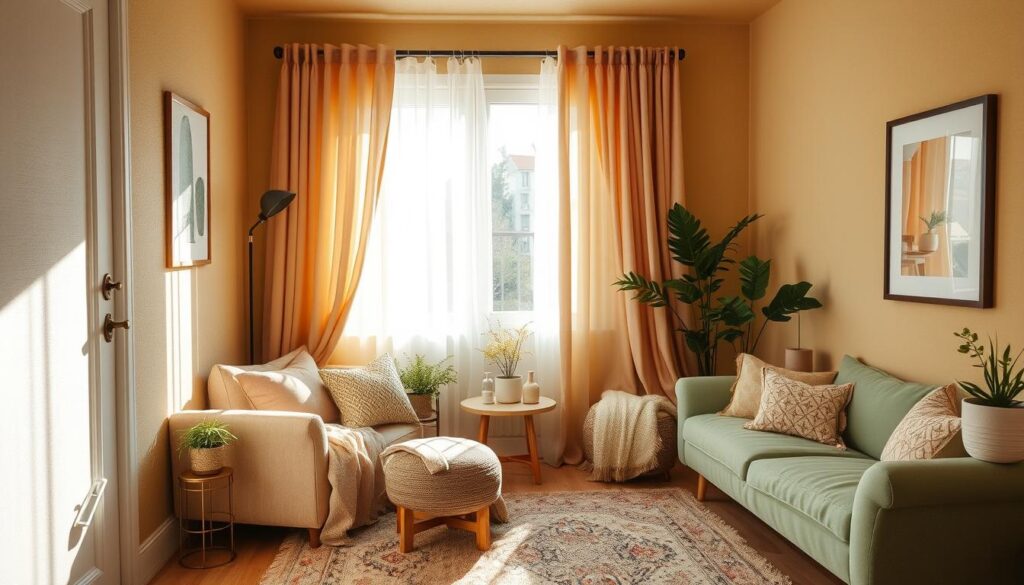
Color Families That Maximize Space
Different color families can have varying effects on the perceived size of a room. Understanding the impact of cool vs. warm tones and saturation levels can help you make an informed decision.
Cool vs. Warm Tones in Small Rooms
Cool tones, such as blues and greens, can create a calming atmosphere and make walls recede, giving the illusion of more space. Warm tones, like oranges and reds, can make a room feel cozier but may also make it feel smaller if overused.
Saturation Levels and Their Effects
Colors with low saturation (more muted or pastel) tend to make walls less noticeable, creating a sense of more space. Highly saturated colors can be overwhelming in small rooms and should be used sparingly, perhaps as accent colors.
By considering these factors and choosing the right light colors, you can effectively make your small room feel more spacious.
White and Off-White Paint Options
In the quest to make small rooms appear more spacious, white and off-white paint colors stand out as top contenders. These hues have the ability to reflect light, creating an illusion of larger space.
Pure Whites for Maximum Light Reflection
Pure white paint colors are ideal for small rooms as they maximize light reflection, making the space feel more expansive. Benjamin Moore’s Chantilly Lace and Super White are excellent choices, offering a clean and crisp finish.
Benjamin Moore’s Chantilly Lace and Super White
Megan Molten, a Charleston interior designer, recommends Benjamin Moore’s Chantilly Lace for its ability to make rooms feel larger. Chantilly Lace provides a soft, warm white tone that is both elegant and spacious.
Sherwin-Williams’ Extra White and High Reflective White
Sherwin-Williams offers Extra White and High Reflective White, both of which are designed to reflect light and enhance the sense of space in small rooms.
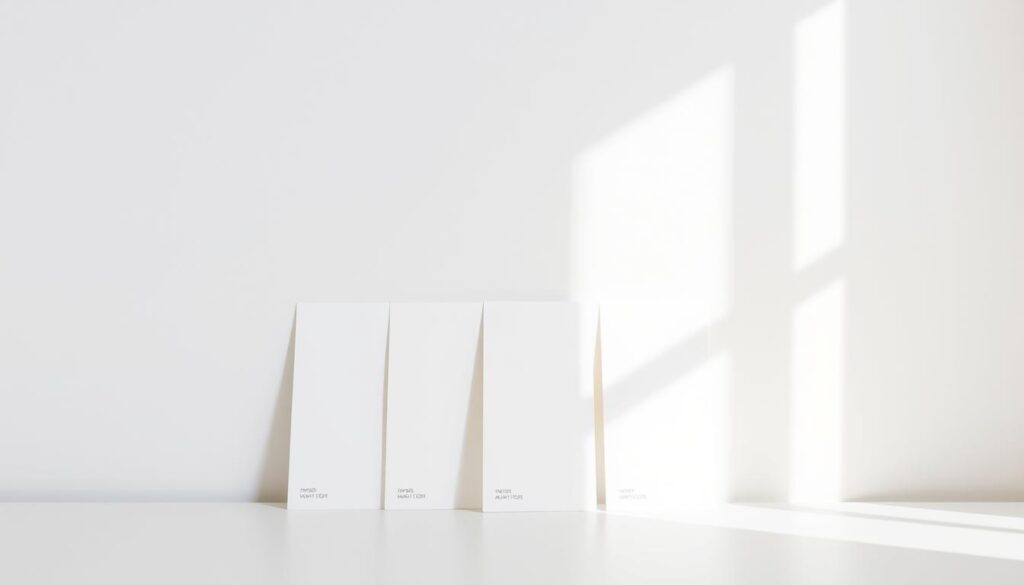
Warm Off-Whites for Coziness Without Confinement
For those seeking a warmer alternative, off-white shades can add coziness to a room without making it feel confined. Benjamin Moore’s Swiss Coffee and White Dove are popular off-white options.
Benjamin Moore’s Swiss Coffee and White Dove
Swiss Coffee offers a warm, creamy tone, while White Dove provides a softer, more subtle hue. Both are versatile choices for small rooms.
Sherwin-Williams’ Alabaster and Creamy
Sherwin-Williams’ Alabaster and Creamy are other warm off-white shades that can make small rooms feel inviting and spacious.
| Brand | Pure White | Warm Off-White |
|---|---|---|
| Benjamin Moore | Chantilly Lace, Super White | Swiss Coffee, White Dove |
| Sherwin-Williams | Extra White, High Reflective White | Alabaster, Creamy |
Light Blues and Greens That Expand Space
Light blues and greens are not just calming colors; they’re also great for creating the illusion of more space in small rooms. These colors have a unique ability to make rooms feel more airy and open, which is particularly beneficial in compact spaces.
Pale Blue Hues for Airy Atmospheres
Pale blue shades can significantly contribute to making small rooms feel larger. They evoke a sense of serenity and openness.
Benjamin Moore’s Breath of Fresh Air and Palladian Blue
Benjamin Moore offers a range of pale blues that are perfect for small rooms. Breath of Fresh Air and Palladian Blue are two such shades that can add a touch of elegance and spaciousness.
Sherwin-Williams’ Rainwashed and Tradewind
Sherwin-Williams also provides excellent options with Rainwashed and Tradewind. These colors are not only soothing but also help in reflecting light, making the room feel more expansive.
Soft Greens for Natural Openness
Soft greens bring a natural and fresh feel to small rooms, making them appear more spacious. These hues are calming and can create a sense of harmony.
Benjamin Moore’s Soft Fern and Spring Mint
Soft Fern and Spring Mint by Benjamin Moore are excellent choices for those looking to introduce a soft green palette. They add a touch of nature and openness.
Sherwin-Williams’ Sea Salt and Mint Condition
Sherwin-Williams’ Sea Salt and Mint Condition are other great options. These colors are versatile and can make small rooms feel more relaxed and spacious.
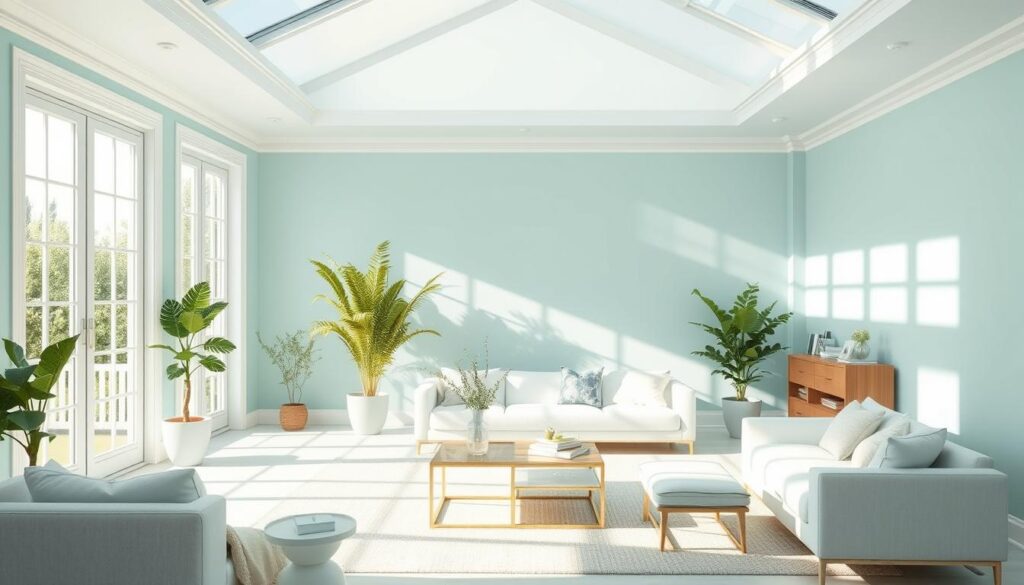
| Brand | Color Name | Description |
|---|---|---|
| Benjamin Moore | Breath of Fresh Air | A pale blue that adds elegance and spaciousness |
| Sherwin-Williams | Rainwashed | A soothing blue shade that reflects light |
| Benjamin Moore | Soft Fern | A soft green that brings a natural feel |
| Sherwin-Williams | Sea Salt | A versatile greenish hue that relaxes and expands the space |
By incorporating these light blues and greens into your small room’s design, you can create a more spacious and airy atmosphere. Whether you choose a pale blue or a soft green, these colors are sure to enhance the feeling of space in your home.
Neutral Tones That Create Depth
Neutral tones offer a versatile solution for creating depth and visual interest in compact spaces. These colors can make small rooms feel larger and more inviting.
Light Grays for Contemporary Spaciousness
Light grays are an excellent choice for creating a sense of spaciousness in small rooms. They provide a clean and contemporary look that can make rooms feel more expansive.
- Benjamin Moore’s Gray Owl: A soft, warm gray that works well in rooms with plenty of natural light.
- Benjamin Moore’s Wickham Gray: A slightly darker gray that adds depth without making the room feel smaller.
- Sherwin-Williams’ Repose Gray: A popular choice for its versatility and ability to complement various decorating styles.
- Sherwin-Williams’ Agreeable Gray: A warm gray that works well with both cool and warm color schemes.
According to interior designer Julie Dodson, painting the trim, walls, and baseboards the same color can make a room feel larger. Light grays are particularly effective for this technique.
Soft Beiges and Taupes for Warmth and Space
Soft beiges and taupes are another excellent option for creating a sense of depth in small rooms. These warm, neutral tones can add coziness without making the space feel confined.
- Benjamin Moore’s Manchester Tan: A warm, beige color that works well in traditional and classic settings.
- Benjamin Moore’s Edgecomb Gray: A soft, warm beige with a hint of gray that adds sophistication.
- Sherwin-Williams’ Accessible Beige: A versatile beige that complements a wide range of decorating styles.
- Sherwin-Williams’ Balanced Beige: A warm, neutral tone that creates a calming atmosphere.
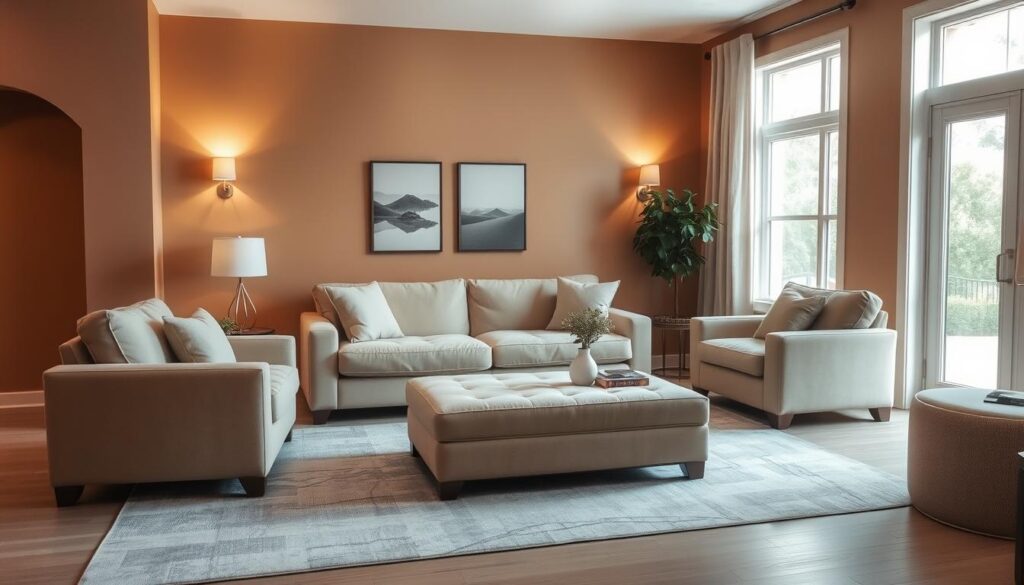
By incorporating these neutral tones into your small room design, you can create a sense of depth and visual interest. Whether you prefer light grays or soft beiges, there’s a perfect shade to enhance your space.
Strategic Color Techniques for Small Rooms
The key to making compact rooms feel more spacious lies in the application of clever color strategies. By understanding how to manipulate color, homeowners can create the illusion of a larger space.
Monochromatic Color Schemes
A monochromatic color scheme involves using different shades of the same color throughout the room. This technique creates a sense of continuity and can make a small room feel more expansive.
Creating Depth with Tonal Variations
To add depth to a monochromatic scheme, use tonal variations. For instance, lighter shades on walls and darker shades on trim can create a sense of layering.
Coordinating Trim and Wall Colors
Coordinating trim and wall colors is crucial in a monochromatic scheme. Choose a trim color that is one shade lighter or darker than the wall color to create a cohesive look.
Accent Walls That Create Dimension
Accent walls can add dimension to a small room by creating a focal point. This technique can distract from the room’s size and draw attention to a particular feature.
Choosing the Right Wall to Accent
When choosing an accent wall, consider the room’s layout and natural light. A wall with a window or door is often a good choice as it creates a sense of balance.
Color Selection for Maximum Impact
The color chosen for the accent wall should be bold and contrasting. According to Jean Liu, an interior designer, using a dark paint color in a high-gloss finish can make a small room appear larger.
| Color Technique | Description | Effect on Small Rooms |
|---|---|---|
| Monochromatic Scheme | Using different shades of the same color | Creates continuity and makes the room feel larger |
| Accent Wall | Using a bold, contrasting color on one wall | Adds dimension and creates a focal point |
| Tonal Variations | Using lighter and darker shades of a color | Adds depth and layering to the room |
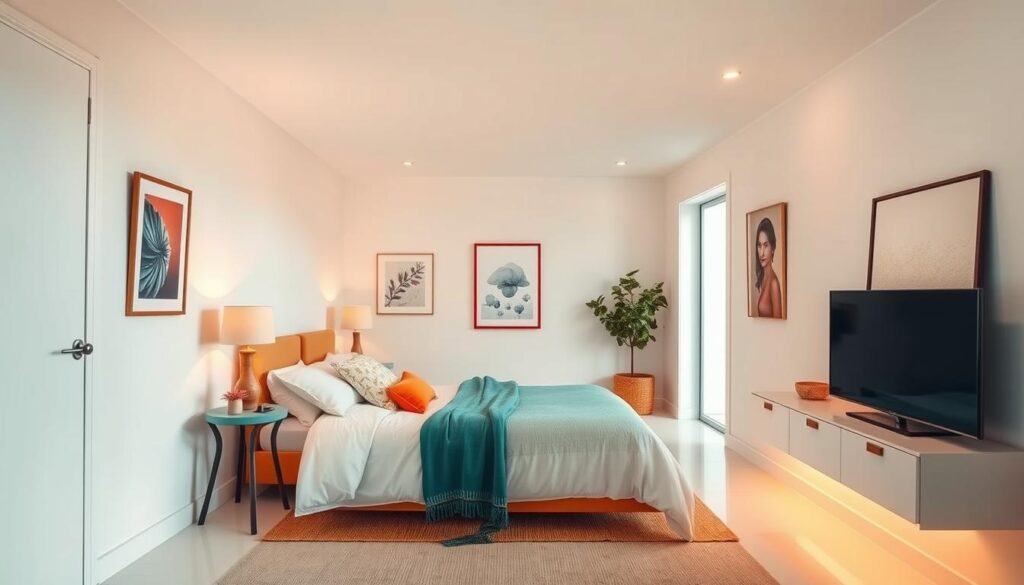
By applying these strategic color techniques, homeowners can make their small rooms feel more spacious and inviting.
Room-Specific Color Recommendations
Effective color selection is key to transforming small rooms into inviting and functional spaces. Different rooms have unique purposes and atmospheres, and the color palette should be chosen accordingly.
Small Bedrooms: Colors for Rest and Space
For small bedrooms, it’s essential to strike a balance between creating a restful environment and making the space feel larger. Calming colors can promote relaxation, while lighter shades can enhance the sense of spaciousness.
Relaxing Blues and Lavenders
Soft blues and lavenders are known for their calming effects, making them ideal for bedrooms. These colors can create a serene atmosphere, conducive to rest and relaxation. Benjamin Moore’s Pale Lavender is a gentle, soothing choice that can add a touch of elegance to small bedrooms.
Sophisticated Neutrals for Sleep Spaces
Neutral tones such as soft grays and creamy whites can also work well in small bedrooms. These colors are sophisticated and can make the room feel more spacious. Hattie Sparks, a New Orleans-based designer, recommends Benjamin Moore’s White Dove to brighten any space, including small bedrooms.
Tight Bathrooms: Making the Most of Limited Area
In tight bathrooms, the right color can create the illusion of more space. Light, reflective colors are particularly effective in making these areas feel more expansive.
Light-Enhancing Whites and Pastels
Whites and pastels are excellent choices for small bathrooms as they reflect light and create a sense of openness. Soft pink or baby blue can add a touch of warmth without making the space feel confined.
Creating Spa-Like Openness
To create a spa-like atmosphere in a tight bathroom, consider using calming colors that promote relaxation. Shades of white, cream, and pale gray can help achieve this ambiance, making the bathroom feel more spacious and serene.
| Room Type | Recommended Colors | Effect |
|---|---|---|
| Small Bedrooms | Soft blues, lavenders, neutral tones | Promotes relaxation, creates sense of space |
| Tight Bathrooms | Whites, pastels, pale grays | Creates illusion of more space, spa-like ambiance |
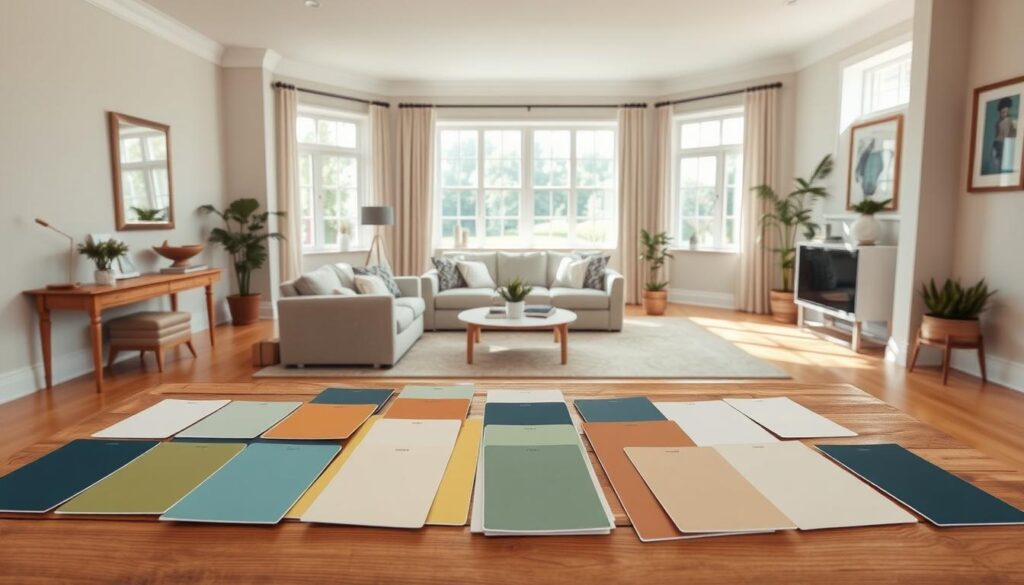
Paint Finishes That Enhance Spaciousness
Choosing the right paint finish is crucial for creating the illusion of more space in small rooms. The finish on your walls can significantly impact how spacious a room feels, making it essential to understand the different types of paint finishes and their effects.
The Impact of Sheen on Space Perception
The sheen of your paint can either make a small room feel cozy or spacious. According to Andrea Magno, Benjamin Moore color and design expert, “The right sheen can add light and depth to your room.” The key is to balance light reflection and durability.
How Light Reflection Varies by Finish
Different paint finishes have varying levels of sheen, which affects how much light is reflected in the room. Flat or matte finishes absorb light, making walls appear more recessive, while higher sheen finishes like satin or semi-gloss reflect light, making rooms appear brighter and more spacious.
Durability Considerations for Small Spaces
In small spaces, it’s also important to consider the durability of the paint finish. Higher traffic areas require more durable finishes, such as satin or semi-gloss, which are easier to clean and maintain.
Best Finishes for Different Room Types
| Room Type | Recommended Finish | Benefits |
|---|---|---|
| Living Areas and Bedrooms | Eggshell or Satin | Balances light reflection and durability, creating a warm and inviting atmosphere. |
| Kitchens, Bathrooms, and High-Traffic Areas | Semi-Gloss or High-Gloss | Highly durable and easy to clean, making them ideal for areas prone to moisture and heavy use. |
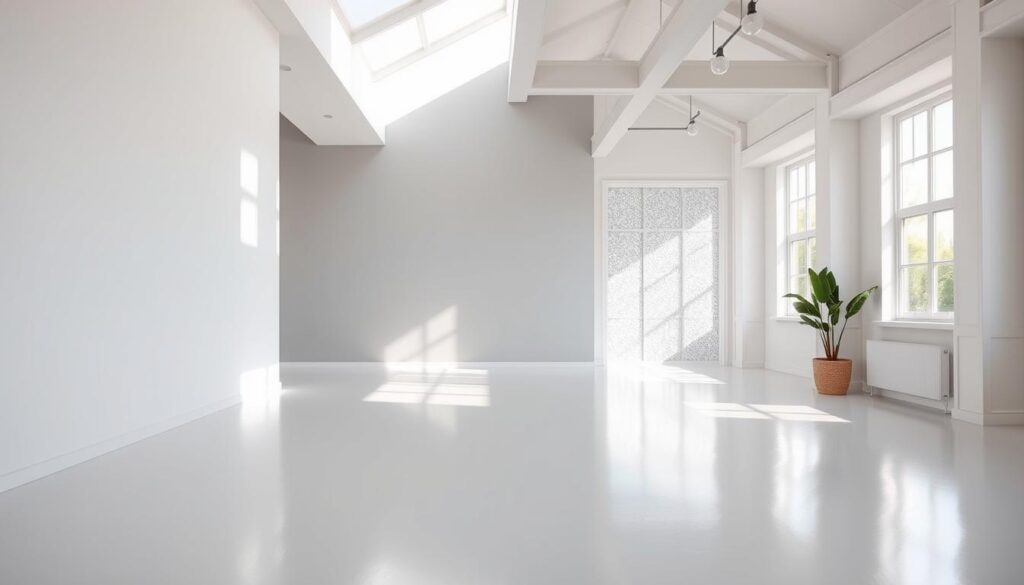
By selecting the appropriate paint finish for your room type, you can enhance the feeling of spaciousness while also ensuring durability and ease of maintenance.
Conclusion: Transforming Your Small Space with Color
Transforming your small space with color can make a significant difference in how spacious it feels. By choosing the right paint colors and finishes, you can create the illusion of a larger area. As discussed, light colors on walls and ceilings can help reflect light and make rooms feel more expansive.
Arianna Cesa, a Benjamin Moore color and design expert, recommends using a light color on the ceiling to create the illusion of height, further enhancing the sense of space. By applying these principles and selecting from a range of suitable colors and finishes, you can transform your small space into a more comfortable and inviting area.
With the right color strategy, you can turn even the smallest rooms into spacious and welcoming environments, ultimately transforming your small space with color.



